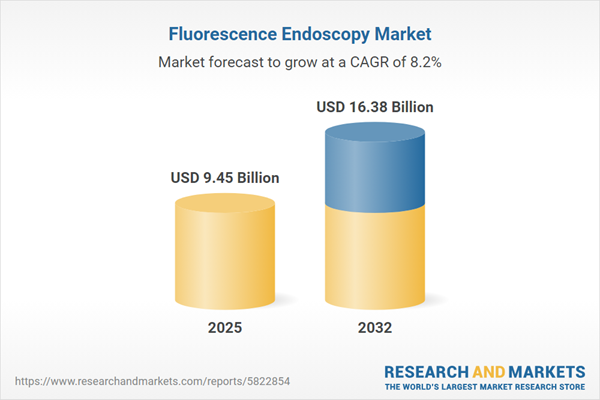Speak directly to the analyst to clarify any post sales queries you may have.
The fluorescence endoscopy market is transforming clinical diagnostics by equipping healthcare decision-makers with innovative imaging solutions that streamline operations, advance diagnostic accuracy, and position organizations to adapt confidently within an evolving medical landscape.
Market Snapshot: Fluorescence Endoscopy Market Size and Growth
The fluorescence endoscopy market is seeing significant and sustained growth, primarily driven by broader adoption of fluorescence-guided imaging across various healthcare environments. As hospitals and specialty clinics seek ways to enhance their diagnostic precision, investments in advanced imaging technology are accelerating. Developments in imaging capabilities are enabling healthcare organizations to modernize care delivery in line with stricter procedural standards and regulatory expectations. This growth is boosting institutional confidence in fluorescence endoscopy, which in turn prompts further adoption and integration throughout healthcare systems. The uptrend creates new commercial opportunities for both vendors and service providers as demand for scalable, reliable imaging platforms increases internationally.
Scope & Segmentation
This market research report provides senior leaders with practical insights to drive capital allocation, procurement, and technology adoption strategies in the fluorescence endoscopy market. Analysis covers every segmentation essential for targeted business outcomes:
- Product Types – Consumables: Bioprobes and fluorescent dyes enable consistent visualization and offer procedural support needed in daily healthcare operations.
- Product Types – Capital Equipment: Capsule endoscopy units and advanced imaging systems furnish scalable options suited to both specialized clinics and large integrated providers.
- Product Types – Support Tools: Training programs, clinical software suites, and technical services promote smooth adoption and sustained operational reliability of new imaging platforms.
- Applications: Technologies span gastrointestinal, colonoscopic, pulmonary, urological, and gynecological diagnostics, delivering flexibility for multispecialty organizations.
- End Users: Imaging solutions address the operational requirements of ambulatory surgical centers, high-throughput clinical settings, and comprehensive health systems that need proven, scalable diagnostic imaging at scale.
- Regional Coverage: Analysis extends to North America, Latin America, Europe, Middle East, Africa, and Asia-Pacific. Emphasis includes detailed perspectives for China, India, Japan, Australia, South Korea, and Southeast Asia, assisting regional strategy and compliance decisions.
- Company Analysis: The report benchmarks industry leaders such as Olympus, Karl Storz, Stryker, Medtronic, and Richard Wolf, equipping decision-makers to assess positioning, explore partnership potential, and shape go-to-market strategies.
Key Takeaways for Executives
- Fluorescence endoscopy expands visualization capabilities, helping care teams deliver improved diagnostic quality across an array of clinical service points.
- The integration of real-time artificial intelligence in imaging technology shortens interpretation timelines and aids rapid decision-making—ensuring optimal use of workforce and capital.
- Advancements in portable and capsule-based diagnostics mean advanced imaging is now feasible for facilities with limited resources, enabling broader and more equitable access to progressive care delivery methods.
- Committed investment in training and technical support optimizes device availability, minimizes downtime, and supports asset sustainability, directly enhancing long-term financial outcomes.
- Partnerships with academic and research organizations help institutions address regulatory evolution and maintain alignment with updated clinical standards while driving ongoing innovation.
- Strategic procurement focused on central objectives strengthens allocation of organizational resources and bolsters growth across diverse healthcare models.
Tariff Impact: Navigating Regulatory and Supply Chain Dynamics
Revisions to U.S. tariff policy have prompted healthcare entities to reevaluate supply chains, increasingly considering regional sourcing to support their procurement strategies. Adaptive regulatory planning and updated logistics are now prominent priorities for market participants, ensuring ongoing operational continuity as trade conditions evolve within the fluorescence endoscopy sector.
Methodology & Data Sources
This report is grounded in direct dialogue with clinical and executive stakeholders, with data supported by structured examination of regulatory updates and the latest market developments. The approach ensures that resulting insights are practical and tailored for executives in the fluorescence endoscopy market.
Why This Report Matters
- Provides actionable intelligence for driving clinical excellence and operational efficiency in both established and emerging healthcare environments.
- Enables leadership to refine resource planning and investment strategy, aligning procurement with long-term value creation goals.
- Clarifies evolving regulatory and logistics challenges, giving organizations the context needed for improved market resilience and preparedness.
Conclusion
The fluorescence endoscopy market continues to set benchmarks for compliance and quality in care delivery. This report supports leaders seeking to adopt advanced imaging solutions and navigate a rapidly changing clinical environment with strategic confidence.
Additional Product Information:
- Purchase of this report includes 1 year online access with quarterly updates.
- This report can be updated on request. Please contact our Customer Experience team using the Ask a Question widget on our website.
Table of Contents
3. Executive Summary
4. Market Overview
7. Cumulative Impact of Artificial Intelligence 2025
Companies Mentioned
The companies profiled in this Fluorescence Endoscopy market report include:- Olympus Corporation
- Karl Storz SE & Co. KG
- Stryker Corporation
- Medtronic plc
- Richard Wolf GmbH
Table Information
| Report Attribute | Details |
|---|---|
| No. of Pages | 187 |
| Published | October 2025 |
| Forecast Period | 2025 - 2032 |
| Estimated Market Value ( USD | $ 9.45 Billion |
| Forecasted Market Value ( USD | $ 16.38 Billion |
| Compound Annual Growth Rate | 8.2% |
| Regions Covered | Global |
| No. of Companies Mentioned | 6 |









